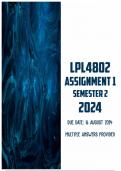, PLEASE USE THIS DOCUMENT AS A GUIDE TO ANSWER YOUR ASSIGNMENT
Please note that the author of this document will not responsibility for any plagiarizing you
commit.
1. Critically discuss the decision of Mdlekeza v Gallie 2021 (4) 531 (wcc) with specific reference
to defamation and the claim for damages in that respect. Do not include a discussion of the
Prescription Act. Your discussion should include (but not limited to) what constitutes
defamation and how the court dealt with this in case, the two-stage inquiry, mitigating and
aggravating factors. You should include your personal view of the decision in this case and
provide reasons for your view.
Answer 1:
The case of Mdlekeza v Gallie (2021 (4) 531 (WCC)) presents a significant instance of defamation
law in South Africa, particularly in how it relates to claims for damages. The core issue in this case
revolves around whether the statements made by the defendant constituted defamation and, if so,
whether the plaintiff is entitled to damages. This discussion will critically examine the elements of
defamation as applied in this case, the court's approach to the two-stage inquiry, and the factors
considered in determining the appropriate award for damages.
Defamation in South African Law
Defamation in South African law is defined as the unlawful and intentional publication of a
statement that injures the reputation of another person. The essential elements of defamation include
the publication of a defamatory statement, the identification of the plaintiff as the subject of the
statement, and an intent to defame. The court generally adopts a two-stage inquiry to determine
whether a statement is defamatory: first, whether the statement was defamatory in nature, and second,
whether the publication of the statement was unlawful.
The Court’s Approach in Mdlekeza v Gallie
In Mdlekeza v Gallie, the court applied the standard principles of defamation law, focusing on
whether the defendant's statements could reasonably be understood as defamatory. The court first
examined the nature of the statements made by the defendant and considered the context in which
they were made. The statements were found to be defamatory as they were likely to diminish the
esteem in which the plaintiff was held by others.
The two-stage inquiry was applied meticulously by the court. In the first stage, the court evaluated
whether the statements were prima facie defamatory. This involved an objective assessment of
whether the statements would likely harm the plaintiff’s reputation. The court concluded that the
statements in question did indeed meet this criterion.
In the second stage, the court considered whether there were any grounds that could render the
publication lawful, such as truth for the public benefit, fair comment, or privilege. The defendant
failed to establish any such defenses, leading to the conclusion that the publication was unlawful.




